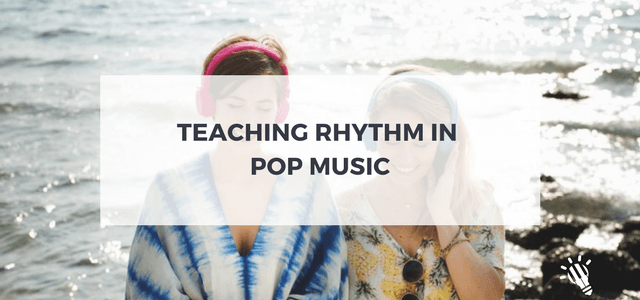 Teaching Rhythm in Pop Music – How do you do it?
Teaching Rhythm in Pop Music – How do you do it?Since launching my online training for piano teachers recently, there have been lots of questions about how to help students ‘find their groove’ in pop music and how teachers can help students with tricky rhythms.
In my opinion, it’s one of the hardest things about teaching pop music, but only if you’re trying to teach from the score.
Take the ubiquitous, “Let it go” from the Disney movie, Frozen (I know, I can hear the groans already – bear with me!). In its original form, this piece is in F minor and features some quite tricky syncopation if the melody is played with the full accompaniment. You can take a look at the original version here on MusicNotes.
While there is an easy arrangement available, it’s hard to avoid the slightly syncopated nature of the theme, so this is still a feature even at the easy level.
While you could have kids sit on the bench and count “1 and 2 and 3 and…” while they first try to clap and then play this tune, I find it much simpler to just say to students: “Here are the notes. Think about how it sounds and then just play those notes in the rhythm that you know”.
Given they’ve probably listened to it a million times, this should come after a it of trial and error. While they might not have actually “read” this from the music, you can now make a connection back to what that rhythm looks like on the music and how it feels and sounds to play. In this way, we’re building on students’ pattern recognition skills which are so vital for fluid music reading.
You could even take it a step further and get them to make up an alternate melody using that rhythm. Can they write it out from memory? Can they try it in the LH? Can they tap the rhythm in the RH while keeping a steady beat in the LH? etc.
These are the types of activities that lend themselves so well to pop music.
Remember above when I said, “…it’s one of the hardest things about teaching pop music, but only if you’re trying to teach from the score”? Well this is where teaching pop through chords can really come in handy and it’s one of the things that I focus on in my training course.
The reality is that when you distil this song down to its underlying chord progression, you’ll quickly realise that the chorus is just a I V vi IV progression. In C, this would be: C G Am F.
The great thing now is that students can play this chord progression pretty easily keeping a steady pace, while you can play the melody over the top. You can then swap roles and they can try the first few melody notes (in time, of course), while you play the chords.
In this way, the students are understanding about chord progressions and are enjoying playing along with their teacher, experimenting with both melody and rhythm.
They can also record themselves playing the chords on their phone and then play this back with headphones while playing the melody over the top.
Another option when rhythm gets tricky is to get students to play along to a backing track. There are a number of apps available for this, but the best I’ve found is NoteStar.
With an app like this, students can play chords along to a full band with vocals and feel like they’re really playing the original score. I show you exactly how do to this in PianoFlix Video 7 for those that are interested.
For more info on great iPad apps for piano teachers, click here.
I found a great article about rhythm in pop music on the Music Matters Blog which sums up my thoughts perfectly:
Please don’t call the rhythm police on me for this, but I usually let them play it however they think it should sound rhythmically. For those who are interested in playing familiar pop music like this, I often just have them figure it out by ear anyway, so that eliminates the discrepancy between how they think it should sound and how it is notated.
While I know this doesn’t answer all questions (how do you teach students to play the melody, chords and bass all at the same time when they are just beginning, for example), I hope it gets you thinking about the ways in which you can approach pop in your lessons.
Remember, students are already reading music in many other aspects of their piano training. If playing pop involves using their ears more than reading, in my opinion, this is a good thing.
How do you teach rhythms? Have you got some good tricks to share? Let me know by leaving a comment below.

jazzman1945 says:
This is an excellent article on the most sensitive issue in piano teaching , It would be possible to convene an international conference on this issue only – it is universal, and not of some teachers! In the mid-90s appeared the first articles about rhythm of pedagogy (as if konnakol or scat singing never existed) precisely because of the problems of the students in the read of pop music charts . There arose an idea that rhythm as the language needs to be studied the rhythmic patterns through prosody . I personally use for this with much success the melodica.